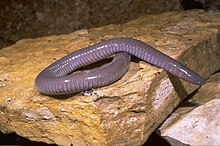
Amphibians are ectothermic, anamniotic, four-limbed vertebrate animals that constitute the class Amphibia. In its broad sense, it is paraphyletic group encompassing all tetrapods excluding the amniotes. All extant (living) amphibians belong to the monophyletic subclass Lissamphibia, with three living orders: Anura (frogs), Urodela (salamanders), and Gymnophiona (caecilians). Evolved to be mostly semiaquatic, amphibians have adapted to inhabit a wide variety of habitats, with most species living in freshwater, wetland or terrestrial ecosystems. Their life cycle typically starts out as aquatic larvae with gills known as tadpoles, but some species have developed behavioural adaptations to bypass this.

Caecilians are a group of limbless, vermiform (worm-shaped) or serpentine (snake-shaped) amphibians with small or sometimes nonexistent eyes. They mostly live hidden in soil or in streambeds, and this cryptic lifestyle renders caecilians among the least familiar amphibians. Modern caecilians live in the tropics of South and Central America, Africa, and southern Asia. Caecilians feed on small subterranean creatures such as earthworms. The body is cylindrical and often darkly coloured, and the skull is bullet-shaped and strongly built. Caecilian heads have several unique adaptations, including fused cranial and jaw bones, a two-part system of jaw muscles, and a chemosensory tentacle in front of the eye. The skin is slimy and bears ringlike markings or grooves and may contain scales.

The eastern mole or common mole is a medium-sized North American mole. It is the only species in the genus Scalopus. It is found in forested and open areas with moist sandy soils in northern Mexico, the eastern United States and the southwestern corner of Ontario in Canada.
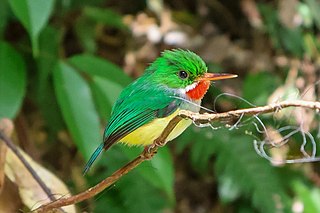
The Puerto Rican tody is a bird endemic to Puerto Rico. It is locally known in Spanish as "San Pedrito" and "medio peso".

The northern slimy salamander is a species of terrestrial plethodontid salamander found throughout much of the eastern two-thirds of the United States.
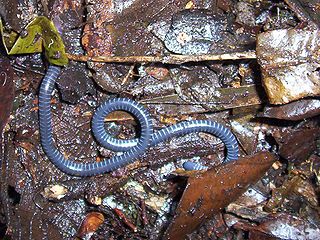
Boulengerula taitana is a species of caecilian. It is endemic to the Taita Hills region of southeast Kenya. Boulengerula taitana are unique caecilians in appearance, fertilization type, and parental care. From their similar shape and presentation to worms, and their internalized fertilization, they set themselves apart from many other amphibians. D. taitana interactions between mothers and newly hatched young is unique in that the mother uses her own skin as a food resource for offspring. This species also has physiological adaptations in place to increase oxygen uptake and affinity to fit their underground lifestyle. The Boulengerula taitana differentiates itself from its close relatives in ways rarely documented and researched before.

Boulengerula niedeni, the Sagalla caecilian, is a worm-like amphibian first described in 2005. The species was described from a specimen discovered on Sagala Hill, an isolated mountain block of the Taita Hills in Kenya, and is not known from other areas.

The Western Ghats in India are home to several species of caecilians (Gymnophiona). Caecilians are legless, burrowing amphibians which mostly live in leaf litter, loose soil, under rocks and decaying logs. They are also found in agricultural fields and only surface during the monsoon. The body is elongated and smooth with a slimy skin. The smaller caecilians superficially resemble earthworms while the larger ones are often mistaken for snakes. However, they can be told apart from earthworms by the presence of eyes, teeth and skeleton and from snakes by the lack of scales on skin. The eyes in caecilians are not well developed which is most likely to be because of their burrowing life style. They are considered as rare which is apparently due to their subterranean habits. To see them one has to search carefully and be at the right place and at the right time. There are few places where they are common, but, at least one species was reported to be abundant in agricultural fields in Kerala. The larger caecilians can resemble snakes, but their skin is smooth, not scaly.
Dermophis costaricense is a species of caecilian in the family Dermophiidae. It is endemic to Costa Rica and is found on the Atlantic versant of Cordillera de Tilarán, Cordillera Central, and Cordillera de Talamanca. Its taxonomic status is in need of a review.
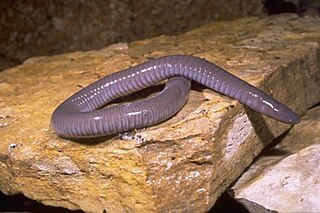
Dermophis is a genus of worm-like amphibians in the family Dermophiidae, the Neotropical and Tropical African caecilians. They are found in the Middle America between southern Mexico and northwestern Colombia. Common names Mexican caecilians or Neotropical caecilians are sometimes used for them.
Dermophis glandulosus is a species of caecilian in the family Dermophiidae. It is found in northwestern Colombia, Costa Rica, and Panama. It is the southernmost species among Dermophis.
Dermophis oaxacae, also known Oaxacan caecilian, is a species of caecilian in the family Dermophiidae. It is endemic to southwestern Mexico and occurs on the Pacific slopes and the Balsas depression in the states of Jalisco, Michoacán, Guerrero, Oaxaca, and Chiapas.

Dermophis parviceps is a species of caecilian in the family Dermophiidae. It is found in Costa Rica and Panama, and possibly in Colombia, depending on the source. Common names slender caecilian and La Loma caecilian have been coined for it.

Herpele squalostoma is a species of caecilian in the family Herpelidae. It is also known by the common name Congo caecilian. It is found in Central and extreme easternmost West Africa.

Siphonops annulatus, the ringed caecilian, is a species of caecilian in the family Siphonopidae from South America. It might have the broadest known distribution among terrestrial caecilian species.

Typhlonectes compressicauda, the Cayenne caecilian, is a species of amphibian in the family Typhlonectidae that lives in water. It is found in Amazonian Brazil, Peru, and Colombia as well as in Guyana and French Guiana, and likely Suriname, and according to some sources, Venezuela. It is an aquatic caecilian that inhabits permanent rivers and marshes mainly in the lowland forest zone.

Ichthyophis glutinosus, the Ceylon caecilian or common yellow-banded caecilian, is a species of caecilian in the family Ichthyophiidae endemic to Sri Lanka. Its natural habitats are moist tropical and subtropical forests and pastures.
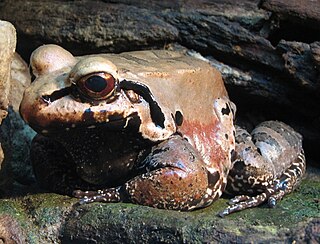
The smoky jungle frog is a species of frog in the family Leptodactylidae. It is found in Bolivia, Brazil, Colombia, Ecuador, Costa Rica, Panama, French Guiana, Perú and Venezuela. Its natural habitats are tropical and subtropical moist broadleaf forests, subtropical or tropical swamps, subtropical or tropical moist montane forest, rivers, freshwater marshes, intermittent freshwater marshes, and aquaculture ponds.
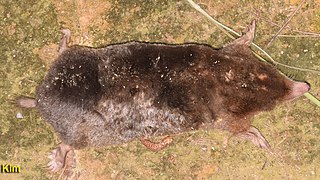
The Ussuri mole or large mole, is a species of mammal in the family Talpidae, formerly treated as a subspecies of the Japanese mole. It is found in China, North Korea, South Korea, and Russia and lives in a long burrow, seldom emerging on the surface of the ground during the day.

The Dermophiidae are a family of common caecilians. They are found in Central and South America, and Africa. Like other caecilians, they superficially resemble worms or snakes.
